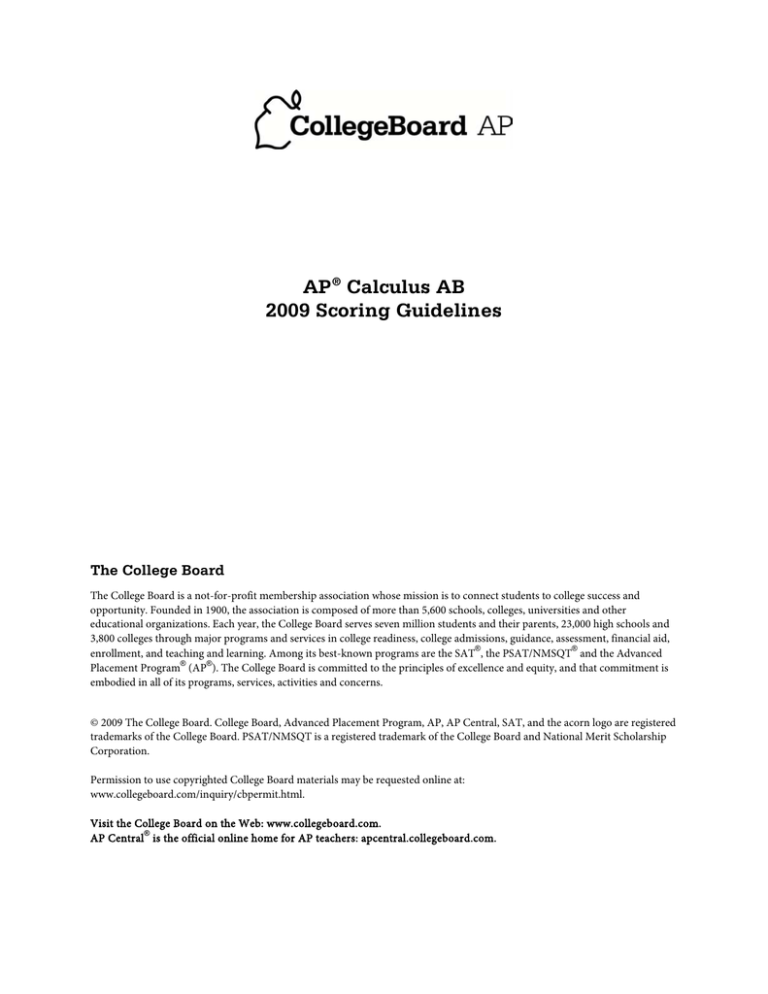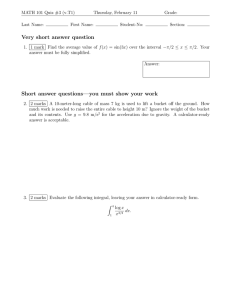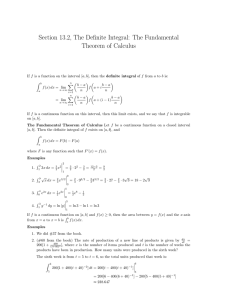
AP® Calculus AB
2009 Scoring Guidelines
The College Board
The College Board is a not-for-profit membership association whose mission is to connect students to college success and
opportunity. Founded in 1900, the association is composed of more than 5,600 schools, colleges, universities and other
educational organizations. Each year, the College Board serves seven million students and their parents, 23,000 high schools and
3,800 colleges through major programs and services in college readiness, college admissions, guidance, assessment, financial aid,
®
®
enrollment, and teaching and learning. Among its best-known programs are the SAT , the PSAT/NMSQT and the Advanced
®
®
Placement Program (AP ). The College Board is committed to the principles of excellence and equity, and that commitment is
embodied in all of its programs, services, activities and concerns.
© 2009 The College Board. College Board, Advanced Placement Program, AP, AP Central, SAT, and the acorn logo are registered
trademarks of the College Board. PSAT/NMSQT is a registered trademark of the College Board and National Merit Scholarship
Corporation.
Permission to use copyrighted College Board materials may be requested online at:
www.collegeboard.com/inquiry/cbpermit.html.
Visit the College Board on the Web: www.collegeboard.com.
®
AP Central is the official online home for AP teachers: apcentral.collegeboard.com.
AP® CALCULUS AB
2009 SCORING GUIDELINES
Question 1
Caren rides her bicycle along a straight road from home to school, starting at home at time t = 0 minutes
and arriving at school at time t = 12 minutes. During the time interval 0 ≤ t ≤ 12 minutes, her velocity
v( t ) , in miles per minute, is modeled by the piecewise-linear function whose graph is shown above.
(a) Find the acceleration of Caren’s bicycle at time t = 7.5 minutes. Indicate units of measure.
12
∫0
(b) Using correct units, explain the meaning of
of
12
∫0
v( t ) dt in terms of Caren’s trip. Find the value
v( t ) dt.
(c) Shortly after leaving home, Caren realizes she left her calculus homework at home, and she returns to
get it. At what time does she turn around to go back home? Give a reason for your answer.
(d) Larry also rides his bicycle along a straight road from home to school in 12 minutes. His velocity is
π
(π )
sin
t , where w( t ) is in miles per minute for
15
12
0 ≤ t ≤ 12 minutes. Who lives closer to school: Caren or Larry? Show the work that leads to your
answer.
modeled by the function w given by w( t ) =
(a) a( 7.5 ) = v′( 7.5 ) =
(b)
12
∫0
v( 8 ) − v( 7 )
= −0.1 miles minute2
8−7
v( t ) dt is the total distance, in miles, that Caren rode
2:
2:
during the 12 minutes from t = 0 to t = 12.
12
∫0
v( t ) dt =
2
4
12
∫ 0 v( t ) dt − ∫ 2 v( t ) dt + ∫ 4
(c) Caren turns around to go back home at time t = 2 minutes.
This is the time at which her velocity changes from positive
to negative.
12
w( t ) dt = 1.6; Larry lives 1.6 miles from school.
12
v( t ) dt = 1.4; Caren lives 1.4 miles from school.
∫0
∫0
Therefore, Caren lives closer to school.
1 : answer
1 : units
1 : meaning of integral
1 : value of integral
v( t ) dt
= 0.2 + 0.2 + 1.4 = 1.8 miles
(d)
{
{
2:
{
1 : answer
1 : reason
⎧ 2 : Larry’s distance from school
⎪
1 : integral
⎪
3: ⎨
1 : value
⎪ 1 : Caren’s distance from school
⎪
and conclusion
⎩
© 2009 The College Board. All rights reserved.
Visit the College Board on the Web: www.collegeboard.com.
AP® CALCULUS AB
2009 SCORING GUIDELINES
Question 2
The rate at which people enter an auditorium for a rock concert is modeled by the function R given by
R( t ) = 1380t 2 − 675t 3 for 0 ≤ t ≤ 2 hours; R( t ) is measured in people per hour. No one is in the
auditorium at time t = 0, when the doors open. The doors close and the concert begins at time t = 2.
(a) How many people are in the auditorium when the concert begins?
(b) Find the time when the rate at which people enter the auditorium is a maximum. Justify your answer.
(c) The total wait time for all the people in the auditorium is found by adding the time each person waits,
starting at the time the person enters the auditorium and ending when the concert begins. The function
w models the total wait time for all the people who enter the auditorium before time t. The derivative
of w is given by w′( t ) = ( 2 − t ) R( t ) . Find w( 2 ) − w(1) , the total wait time for those who enter the
auditorium after time t = 1.
(d) On average, how long does a person wait in the auditorium for the concert to begin? Consider all people
who enter the auditorium after the doors open, and use the model for total wait time from part (c).
(a)
2
∫ 0 R( t ) dt = 980 people
2:
(b) R′( t ) = 0 when t = 0 and t = 1.36296
The maximum rate may occur at 0, a = 1.36296, or 2.
R( 0 ) = 0
R( a ) = 854.527
R( 2 ) = 120
{
1 : integral
1 : answer
⎧ 1 : considers R′( t ) = 0
⎪
3 : ⎨ 1 : interior critical point
⎪⎩ 1 : answer and justification
The maximum rate occurs when t = 1.362 or 1.363.
(c) w( 2 ) − w(1) =
2
2:
{
1 : integral
1 : answer
2:
{
1 : integral
1 : answer
2
∫ 1 w′( t ) dt = ∫ 1 ( 2 − t ) R( t ) dt = 387.5
The total wait time for those who enter the auditorium after
time t = 1 is 387.5 hours.
(d)
1
1 2
w( 2 ) =
( 2 − t ) R ( t ) dt = 0.77551
980
980 0
On average, a person waits 0.775 or 0.776 hour.
∫
© 2009 The College Board. All rights reserved.
Visit the College Board on the Web: www.collegeboard.com.
AP® CALCULUS AB
2009 SCORING GUIDELINES
Question 3
Mighty Cable Company manufactures cable that sells for $120 per meter. For a cable of fixed length, the
cost of producing a portion of the cable varies with its distance from the beginning of the cable. Mighty
reports that the cost to produce a portion of a cable that is x meters from the beginning of the cable is
6 x dollars per meter. (Note: Profit is defined to be the difference between the amount of money
received by the company for selling the cable and the company’s cost of producing the cable.)
(a) Find Mighty’s profit on the sale of a 25-meter cable.
(b) Using correct units, explain the meaning of
30
∫ 25 6
x dx in the context of this problem.
(c) Write an expression, involving an integral, that represents Mighty’s profit on the sale of a cable that
is k meters long.
(d) Find the maximum profit that Mighty could earn on the sale of one cable. Justify your answer.
(a) Profit = 120 ⋅ 25 −
(b)
30
∫ 25 6
25
∫0
6 x dx = 2500 dollars
x dx is the difference in cost, in dollars, of producing a
2:
{
1 : integral
1 : answer
1 : answer with units
cable of length 30 meters and a cable of length 25 meters.
(c) Profit = 120k −
k
∫0 6
x dx dollars
(d) Let P ( k ) be the profit for a cable of length k.
P′( k ) = 120 − 6 k = 0 when k = 400.
This is the only critical point for P, and P′ changes from
positive to negative at k = 400.
Therefore, the maximum profit is P( 400 ) = 16,000 dollars.
2:
{
1 : integral
1 : expression
⎧ 1 : P′( k ) = 0
⎪⎪ 1 : k = 400
4: ⎨
⎪ 1 : answer
⎪⎩ 1 : justification
© 2009 The College Board. All rights reserved.
Visit the College Board on the Web: www.collegeboard.com.
AP® CALCULUS AB
2009 SCORING GUIDELINES
Question 4
Let R be the region in the first quadrant enclosed by the graphs of y = 2 x and
y = x 2 , as shown in the figure above.
(a) Find the area of R.
(b) The region R is the base of a solid. For this solid, at each x the cross
section perpendicular to the x-axis has area A( x ) = sin
( π2 x ). Find the
volume of the solid.
(c) Another solid has the same base R. For this solid, the cross sections
perpendicular to the y-axis are squares. Write, but do not evaluate, an
integral expression for the volume of the solid.
(a) Area =
2
∫ 0 ( 2 x − x ) dx
2
= x2 −
1 3
x
3
⎧ 1 : integrand
⎪
3 : ⎨ 1 : antiderivative
⎪⎩ 1 : answer
x=2
x =0
4
=
3
( )
π
2
= − cos ( x )
2
π
2
⎮ sin π x dx
(b) Volume = ⌠
2
⌡0
=
x=2
x =0
⎧ 1 : integrand
⎪
3 : ⎨ 1 : antiderivative
⎪⎩ 1 : answer
4
π
(
⌡
(c) Volume = ⌠
⎮
4
0
y −
y
2
)
2
dy
3:
{
2 : integrand
1 : limits
© 2009 The College Board. All rights reserved.
Visit the College Board on the Web: www.collegeboard.com.
AP® CALCULUS AB
2009 SCORING GUIDELINES
Question 5
x
2
3
5
8
13
f ( x)
1
4
–2
3
6
Let f be a function that is twice differentiable for all real numbers. The table above gives values of f for
selected points in the closed interval 2 ≤ x ≤ 13.
(a) Estimate f ′( 4 ) . Show the work that leads to your answer.
(b) Evaluate
13
∫2
( 3 − 5 f ′( x ) ) dx. Show the work that leads to your answer.
(c) Use a left Riemann sum with subintervals indicated by the data in the table to approximate
13
∫2
f ( x ) dx.
Show the work that leads to your answer.
(d) Suppose f ′( 5 ) = 3 and f ′′( x ) < 0 for all x in the closed interval 5 ≤ x ≤ 8. Use the line tangent to
the graph of f at x = 5 to show that f ( 7 ) ≤ 4. Use the secant line for the graph of f on 5 ≤ x ≤ 8 to
4
show that f ( 7 ) ≥ .
3
(a)
(b)
f ′( 4 ) ≈
13
∫2
f ( 5 ) − f ( 3)
= −3
5−3
( 3 − 5 f ′( x ) ) dx =
13
∫2
3 dx − 5∫
1 : answer
13
2
f ′( x ) dx
= 3 (13 − 2 ) − 5 ( f (13) − f (2) ) = 8
(c)
13
∫2
f ( x ) dx ≈ f ( 2 )( 3 − 2 ) + f ( 3)( 5 − 3)
+ f ( 5 )( 8 − 5 ) + f ( 8 )(13 − 8 ) = 18
(d) An equation for the tangent line is y = −2 + 3 ( x − 5 ) .
Since f ′′( x ) < 0 for all x in the interval 5 ≤ x ≤ 8, the
line tangent to the graph of y = f ( x ) at x = 5 lies above
the graph for all x in the interval 5 < x ≤ 8.
Therefore, f ( 7 ) ≤ −2 + 3 ⋅ 2 = 4.
⎧ 1 : uses Fundamental Theorem
⎪
2: ⎨
of Calculus
⎪⎩ 1 : answer
2:
{
1 : left Riemann sum
1 : answer
⎧ 1 : tangent line
⎪ 1 : shows f ( 7 ) ≤ 4
⎪
4 : ⎨ 1 : secant line
⎪
⎪ 1 : shows f ( 7 ) ≥ 4
⎩
3
5
( x − 5).
3
Since f ′′( x ) < 0 for all x in the interval 5 ≤ x ≤ 8, the
secant line connecting ( 5, f ( 5 ) ) and ( 8, f ( 8 ) ) lies below
the graph of y = f ( x ) for all x in the interval 5 < x < 8.
5
4
Therefore, f ( 7 ) ≥ −2 + ⋅ 2 = .
3
3
An equation for the secant line is y = −2 +
© 2009 The College Board. All rights reserved.
Visit the College Board on the Web: www.collegeboard.com.
AP® CALCULUS AB
2009 SCORING GUIDELINES
Question 6
The derivative of a function f is defined by
for − 4 ≤ x ≤ 0
⎧ g( x)
f ′( x ) = ⎨ − x 3
.
− 3 for 0 < x ≤ 4
⎩ 5e
The graph of the continuous function f ′, shown in the figure above, has
5
x-intercepts at x = −2 and x = 3ln
. The graph of g on − 4 ≤ x ≤ 0
3
is a semicircle, and f ( 0 ) = 5.
()
(a) For − 4 < x < 4, find all values of x at which the graph of f has a point of inflection. Justify your
answer.
(b) Find f ( − 4 ) and f ( 4 ) .
(c) For − 4 ≤ x ≤ 4, find the value of x at which f has an absolute maximum. Justify your answer.
(a)
f ′ changes from decreasing to increasing at x = −2 and from
increasing to decreasing at x = 0. Therefore, the graph of f has
points of inflection at x = −2 and x = 0.
(b) f ( − 4 ) = 5 +
−4
∫0
g ( x ) dx
−x 3
∫ 0 ( 5e − 3) dx
x=4
= 5 + ( −15e − x 3 − 3x )
x =0
4
= 8 − 15e − 4
3
(c) Since f ′( x ) > 0 on the intervals −4 < x < −2 and
5
−2 < x < 3ln
, f is increasing on the interval
3
5
− 4 ≤ x ≤ 3ln
.
3
()
()
Since f ′( x ) < 0 on the interval 3ln
decreasing on the interval 3ln
{
1 : identifies x = −2 or x = 0
1 : answer with justification
⎧ 2 : f ( −4)
⎪
1 : integral
⎪
1 : value
⎪
⎪
5 : ⎨ 3 : f ( 4)
⎪
1 : integral
⎪
1 : antiderivative
⎪
⎪⎩
1 : value
= 5 − ( 8 − 2π ) = 2π − 3
f ( 4) = 5 +
2:
2:
{
1 : answer
1 : justification
( 53 ) < x < 4, f is
( 53 ) ≤ x ≤ 4.
Therefore, f has an absolute maximum at x = 3ln
( 53 ).
© 2009 The College Board. All rights reserved.
Visit the College Board on the Web: www.collegeboard.com.




